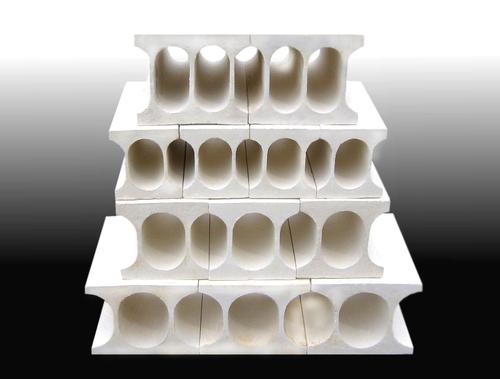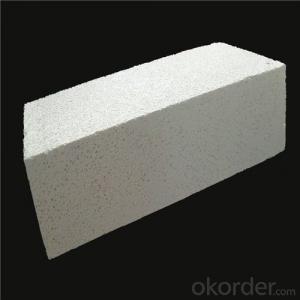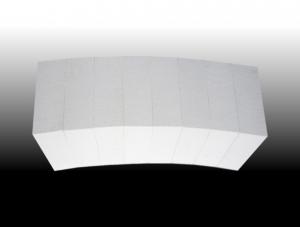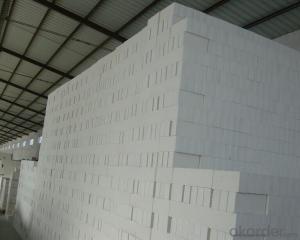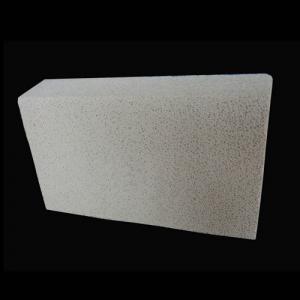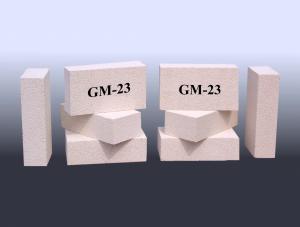Insulating Fire Brick GJM23 - High-Quality Insulation for Fire Safety
- Loading Port:
- China Main Port
- Payment Terms:
- TT OR LC
- Min Order Qty:
- -
- Supply Capability:
- -
OKorder Service Pledge
Quality Product, Order Online Tracking, Timely Delivery
OKorder Financial Service
Credit Rating, Credit Services, Credit Purchasing
You Might Also Like
General Information
CMAX insulating firebricks are classified under temperature between 1300℃ to 1700℃, manufactured from high purity alumina clay.
Feature
Light weight and low thermal conductivity
Low heat storage
Low iron and impurities
High thermal shock resistance
Application
CMAX insulating firebricks can be used as a hot face lining directly exposed to the heat or as a backup insulation layer in iron and steel mills, non-ferrous foundries, petrochemical, ceramic, glass.
- Q: Do insulating fire bricks require special storage conditions?
- Yes, insulating fire bricks do require special storage conditions. They should be stored in a dry and well-ventilated area to prevent moisture absorption, which can lead to cracking or spalling during use. Additionally, they should be protected from extreme temperatures and direct sunlight, as these can affect their integrity and performance.
- Q: Can insulating fire bricks be used in the construction of tundishes?
- Insulating fire bricks are indeed applicable for tundish construction. They possess exceptional thermal insulation qualities and are lightweight, which makes them perfect for situations that demand heat retention. Tundishes, utilized in the steel industry to regulate molten metal flow, necessitate materials capable of enduring high temperatures while minimizing heat loss. Insulating fire bricks excel in this area, successfully enduring extreme temperatures within tundishes, thereby safeguarding the desired molten metal temperature and preventing heat loss. Moreover, their lightweight nature facilitates uncomplicated handling and installation during tundish construction. In conclusion, insulating fire bricks prove to be a suitable choice for tundish construction due to their thermal insulation qualities and ability to withstand high temperatures.
- Q: Are insulating fire bricks lightweight or heavy?
- Insulating fire bricks are lightweight. These bricks are specifically designed to have low density and high insulating properties. They are made from lightweight materials such as expanded clay, perlite, and vermiculite, which contribute to their lightweight nature. This makes them easier to handle and install compared to traditional heavy fire bricks. However, despite being lightweight, insulating fire bricks still offer excellent thermal insulation, making them ideal for various applications including kilns, furnaces, and fireplaces.
- Q: Are insulating fire bricks easy to handle and install?
- Insulating fire bricks are generally easy to handle and install. They are lightweight, making them easy to transport and carry around. Additionally, their shape and size are designed to be user-friendly, allowing for easy manipulation and installation. Most insulating fire bricks come with pre-drilled holes or grooves, which further simplifies the installation process. Moreover, these bricks can be easily cut or shaped to fit specific dimensions or requirements, making them highly versatile. Overall, insulating fire bricks are considered easy to handle and install, even for individuals with limited experience or knowledge in masonry work.
- Q: Can insulating fire bricks be used in the construction of steel production furnaces?
- Yes, insulating fire bricks can be used in the construction of steel production furnaces. These bricks have high heat resistance and low thermal conductivity, making them ideal for insulating the furnace and preventing heat loss. Their ability to withstand extremely high temperatures makes them suitable for use in steel production furnaces where temperatures can reach several thousand degrees Celsius.
- Q: Can insulating fire bricks be used for insulation in sewage treatment plants?
- Insulating fire bricks are capable of being utilized for insulation purposes in sewage treatment plants. Specifically designed to endure elevated temperatures and deliver exceptional insulation, these bricks prove to be suitable for deployment in environments characterized by heat and moisture, such as sewage treatment plants. With their low thermal conductivity, they aid in diminishing heat loss and enhancing energy efficiency throughout the treatment procedure. Furthermore, their resistance to chemicals and moisture renders them ideal for enduring the corrosive surroundings typically encountered in sewage treatment plants. Consequently, the usage of insulating fire bricks effectively ensures insulation in sewage treatment plants, thereby aiding in the preservation of optimal operating temperatures and the enhancement of overall efficiency.
- Q: How do insulating fire bricks affect the overall energy consumption of a building?
- Insulating fire bricks can significantly reduce the overall energy consumption of a building by providing better insulation. These bricks have low thermal conductivity, which means they are effective in preventing heat transfer through walls and other surfaces. By minimizing heat loss during cold weather and heat gain during hot weather, insulating fire bricks help maintain a stable indoor temperature, reducing the need for heating and cooling systems. This results in lower energy usage and cost savings for the building's occupants.
- Q: Why does the water drop first and then rise when the boiler fires?
- Often in the operation of the boiler, the steam water mixture to the drum after intense evaporation of a large number of bubbles in the water side, the water volume expansion. By actual water level drum water level indicator is higher than the water level
- Q: Are insulating fire bricks resistant to moisture penetration?
- Insulating fire bricks exhibit resistance to moisture penetration, as they are designed with low porosity, resulting in a minimal water absorption rate. This attribute grants them formidable protection against moisture infiltration. These bricks find frequent application in environments characterized by elevated temperatures and harsh conditions, including kilns, furnaces, and fireplaces. Their durability and effectiveness in such settings are guaranteed by their ability to ward off moisture penetration.
- Q: Can insulating fire bricks be used for kiln furniture?
- Indeed, kiln furniture can be fashioned from insulating fire bricks. These bricks are specifically engineered to endure extreme temperatures and are frequently employed in industrial kilns and furnaces. Their exceptional thermal insulation characteristics render them perfect for crafting kiln furniture like shelves, posts, and supports. The insulating attributes of these bricks aid in the uniform dispersion of heat throughout the kiln, guaranteeing consistent heating of the items being fired. Furthermore, insulating fire bricks possess a lightweight composition and are effortlessly manageable, thereby making them a convenient selection for kiln furniture.
Send your message to us
Insulating Fire Brick GJM23 - High-Quality Insulation for Fire Safety
- Loading Port:
- China Main Port
- Payment Terms:
- TT OR LC
- Min Order Qty:
- -
- Supply Capability:
- -
OKorder Service Pledge
Quality Product, Order Online Tracking, Timely Delivery
OKorder Financial Service
Credit Rating, Credit Services, Credit Purchasing
Similar products
Hot products
Hot Searches
Related keywords

